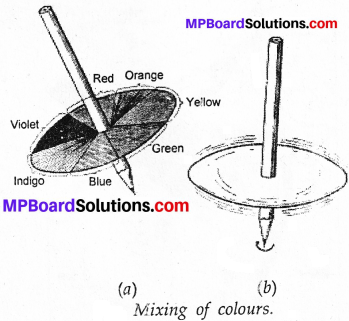MP Board Class 7th Science Solutions Chapter 15 Light
Light Intex Questions
Question 1.
Paheli wants to know, what makes things visible to us? Boojho thinks that objects are visible only when light reflected from them reaches our eyes. Do you agree with him?
Answer:
Yes.
Question 2.
Boojho noted in his notebook: Is it not surprising that my image is of the same size as me whether the mirror is small or large?
Answer:
Yes.
![]()
Question 3.
Paheli made a note in her notebook: In a plane mirror the image is formed behind the mirror. It is erect, of the same size and is at the same distance from the mirror as the object is in front of it?
Answer:
Yes.
Question 4.
Boojho saw an ambulance on the road. He was surprised to see that the word ‘AMBULANCE’ in front was written in a strange manner?
Answer:
When the driver of a vehicle ahead of an ambulance looks in her/his rear view mirror, he/she can read ‘AMBULANCE’ written on it and give way to it. It is the duty of every one of us to allow an ambulance to pass without blocking its way.
Activities
Activity – 1
Write down the letters ABC on a piece of paper with sketch pen and look at its image in a plane mirror. Then find out which letters look the same as on the paper and which letters look different (fig.) Try to write these letters as seen in the mirror
Answer:
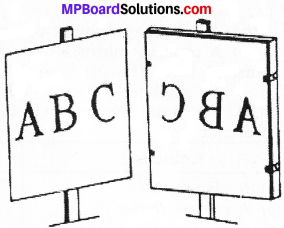
Activity – 2
Take a red book and allow white light to fall on it (fig)
Answer:
The color of the book is due to the red color which gets reflected from the book, i.e., it reflects only red color while it absorbs all the other colours of white light. A rose is red because it reflects only red light.
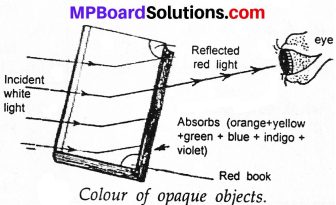
Light Text Book Exercises
Question 1.
Fill in the blanks:
- An image that cannot be obtained on a screen is called ………………………..
- Image formed by a convex ……………………….. is always virtual and smaller in size.
- An image formed by a …………………….. mirror is always of the same size as that of the object.
- An image which can be obtained on a screen is called a ………………………….. image.
- An image formed by a concave ………………………. cannot be obtained on a screen.
Answer:
- Virtual image
- Mirror
- Plane
- Real
- Lens
Question 3.
Match the items given in of Column I with one or more items Column II:
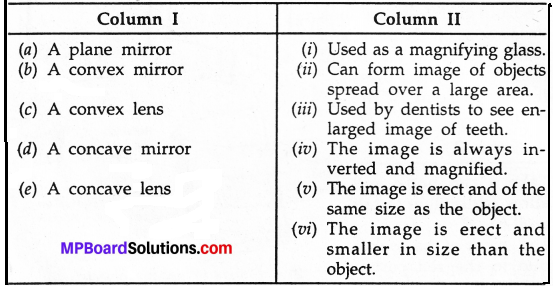
Answer:
1. (a) – (v)
2. (b) – (ii)
3. (c) – (i)
4. (d) – (iii)
5. (e) – (vi)
Question 4.
State the characteristics of the image formed by a plane mirror?
Answer:
The characteristics of the image formed by a plane mirror are:
- It forms an erect image.
- It forms a virtual image.
- It forms the image behind the mirror.
- The size of the image is same as that of the object.
- It forms the image at the same distance behind the mirror as the object stands infront of it.
Question 5.
Find out the letters of English alphabet or any other language known to you in which the image formed in a plane mirror appears exactly like the letter itself. Discuss your findings?
Answer:
Letters like A, H, I, M, O, T, U, V, and W.
Question 6.
What is a virtual image? Give one situation where a virtual image is formed?
Answer:
The image which cannot be taken on a screen is called a virtual image. For example, when some object is placed very close to the concave mirror we do not get any image of that object on the white screen placed behind the mirror. This type of image is known as virtual image.
![]()
Question 7.
State two differences between a convex and a concave lens?
Answer:
Convex lens:
- These are thick at middle and thin at edge.
- They can form magnified image.
Concave lens:
- These are thin at middle and thick at edge.
- The image formed by these lens are always diminished in size.
Question 8.
Give one use each of a concave and convex mirror?
Answer:
Use of convex mirror:
It is used in vehicles as rear view mirror.
Concave mirror:
It is used by dentists to examine is used in vehicles as rear view mirror.
Question 9.
Which type of mirror can form a real image?
Answer:
Concave mirror.
Question 10.
Which type of lens forms always a virtual image?
Answer:
Concave lens.
![]()
Choose the correct option in questions 11 – 13:
Question 11.
A virtual image larger than the object can be produced by a –
- Concave lens
- Concave mirror
- Convex mirror
- Plane mirror
Answer:
2. concave mirror
Question 12.
David is observing his image in a plane mirror. The distance between the mirror and his image is 4 m. If he moves 1 m towards the mirror, then the distance between David and his image will be –
1. 3 m
2. 5 m
3. 6 m
4. 8 m.
Answer:
3. 6 m
Question 13.
The rear view mirror of a car is a plane mirror. A driver is reversing his car at a speed of 2 m/s. The driver sees in his rear view mirror the image of a truck parked behind his car. The speed at which the image of the truck appears to approach the driver will be –
1. 1 m/s
2. 2 m/s
3. 4 m/s
4. 8 m/s.
Answer:
3. 4 m/s
![]()
Extended Learning – Activities and Projects
Question 1.
Play with mirror? Write your name with a sketch pen on a thin sheet of paper, polythene or glass. Read your name on the sheet while standing infront of a plane mirror. Now look at your image in the mirror?
Answer:
Do yourself
Question 2.
A burning candle in water? Take a shoe box, open on one side. Place a small lighted candle in it. Place a clear glass sheet Fig- Candle burning in water (roughly 25 cm x 25 cm) infront of this candle (Fig.). Try to locate the image of the candle behind the glass sheet. Place a glass of water at its position. Ask your friends to look at the image of the candle through the sheet of glass. Ensure that candle is not visible to your friends. Your friends will be surprised to see the candle burning in water. Try to explain the reason?
Answer:
Do yourself.
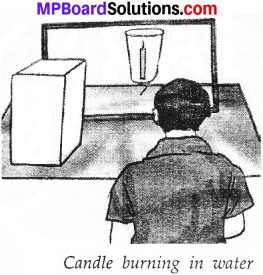
Question 3.
Make a rainbow?
Try to make your own rainbow. You can try this project in the morning or in the evening. Stand with your back towards the sun/ Take a hosepipe or a water pipe used in the garden. Make a fine spray in front of you. You can see different colours of rainbow in the spray?
Answer:
Do yourself.
Question 4.
Visit a laughing gallery in some science centre or a science park or a village mela. You will find some large mirrors there. You can see your distorted and funny images in these mirrors. Try to find out the kind of mirrors used there?
Answer:
Do yourself.
Question 5.
Visit a nearby hospital. You can also visit the clinic of an ENT specialist, or a dentist. Request the doctor to show you the mirrors used for examining ear, nose, throat and teeth. Can you recognise the kind of mirror used in these instruments?
Answer:
Do yourself.
![]()
Question 6.
Role play?
Here is a game that a group of children can play. One child will be chosen to act as object and another will act as the image of the object. The object and the image will sit opposite to each other. The object will make movements, such as raising a hand touching an ear, etc. The image will have to make the correct movement following the movement of the object. The rest of the group will watch the movements of the image. If the image fails to make the correct movement, she/he will be retired. Another child will take her/his place and the game will continue. A scoring scheme can be introduced. The group that scores the maximum will be declared the winner?
Answer:
Do yourself.
Light Additional Important Questions
Objective Type Questions
Question 1.
Choose the correct alternative:
Question (a)
Formation of shadows suggests that light travels in –
(a) vacuum
(b) straight lines
(c) dark rooms
(d) None of these.
Answer:
(b) straight lines
Question (b)
A smooth polished surface which can return back the rays of light into the same medium is called –
(a) mirror
(b) lens
(c) prison
(d) None of these.
Answer:
(a) mirror
![]()
Question (c )
The phenomenon of bouncing back of the rays of light into the same medium is called –
(a) reflection
(b) refraction
(c) scattering
(d) None of these.
Answer:
(a) reflection
Question (d)
If the image cannot be taken on the screen, it must be –
(a) real
(b) virtual
(c) real or virtual
(d) None of these.
Answer:
(b) virtual
Question (e)
A spherical mirror with its reflecting surface on the outside is a –
(a) plane mirror
(b) convex mirror
(c) concave mirror
(d) None of these.
Answer:
(b) convex mirror
![]()
Question (f)
The mirror which is used as rear – view mirror in cars and scooters is, by nature –
(a) plane
(b) convex
(c) concave
(d) None of these.
Answer:
(b) convex
Question (g)
An image that can be obtained on a screen is –
(a) virtual
(b) real
(c) both real and virtual
(d) None of these.
Answer:
(b) real
Question (h)
The image produced by a plane mirror is –
(a) small
(b) real
(c) inverted
(d) equal size virtual and erect.
Answer:
(d) equal size virtual and erect.
![]()
Question (i)
In the formation of rainbow the altitude of the sun should be between or less than –
(a) 40° to 42°
(b) 42° to 44°
(c) 41° to 43°
(d) 0° to 40°.
Answer:
(a) 40° to 42°
Question (j)
White light comprises of ……………………… colours?
(a) 7
(b) 5
(c) 3
(d) 8.
Answer:
(a) 7
Question (k)
Which of the following can be used to prove that light consists of seven colours?
(a) plane mirror
(b) convex lens
(c) Newton’s disc
(d) None of these.
Answer:
(c) Newton’s disc
Question (l)
If the speed of rotation of Newton’s colour disc is fast enough, the various colours would blend and produce –
(a) white light
(b) red light
(c) no light at all
(d) green light.
Answer:
(a) white light
![]()
Question (m)
Primary colours are –
(a) red, blue, yellow
(b) red, yellow, magenta
(c) red, blue, green
(d) None of these.
Answer:
(c) red, blue, green
Question (n)
Which color is produced by mixing of blue and green?
(a) cyan
(b) magenta
(c) yellow
(d) blue.
Answer:
(a) cyan
Question 2.
Fill in the blanks:
- The surface of water can act like a mirror and change the path of …………………………
- An image formed by a plane mirror is erect and of the same size as the ……………………
- The curved shining surface of a spoon acts as a ……………………
- The inner surface of the cut ball is called and the outer surface is called ………………………
- Concave mirrors are also used by dentists to see an enlarged image of the ………………………
- The reflectors of tourches, headlights of cars and scooters are ……………………….. in shape.
- The magnifying glass is actually a type of a ……………………………..
- A convex lens is also called ………………………….. lens.
- A concave lens is also called ……………………….. lens.
- The rainbow has ………………………… colours.
- The process of splitting up of white light into different colours is called ……………………
- In a common rainbow the …………………………. colour is observed in the inner fringe and ………………………. on the outer fringe.
Answer:
- Light
- Object
- Mirror
- Concave, convex
- Teeth
- Concave
- Lens
- Converging
- Diverging
- Seven
- Dispersion of light
- Violet, red.
![]()
Question 3.
Which of the following statements are true (T) or false (F):
- A shining stainless steel’spoon or plate can change the direction of light.
- In a plane mirror only sides are interchanged.
- The common example of a curved mirror is a spherical mirror.
- The reflecting surface of the bell is convex.
- Convex mirrors can form images of objects spread over a large area.
- The lenses are not transparent.
- A concave lens always forms erect, virtual and smaller image than the object.
- A rainbow is seen as a large arc in the sky with many colours.
- The sunlight consists of five colours.
- The white light is composed of seven colours.
Answer:
- True
- Ture
- True
- True
- True
- False
- True
- True
- False
- True
Light Very Short Answer Type Questions
Question 1.
Give the names of four different sources of light?
Answer:
The four different sources of light are:
- Sun
- Stars
- Moon
- Firefly.
Question 2.
How does light travel from one point to the other?
Answer:
Light travel from one point to the other in straight line.
Question 3.
How can we change the direction of the light?
Answer:
We can change the direction of light by the phenomenon called reflection.
![]()
Question 4.
What is refraction?
Answer:
Bending of light when it travels from one medium to another is called refraction.
Question 5.
Define concave mirror?
Answer:
In a spherical mirror, of the reflecting surface is on the inside, it is called a concave mirror.
Question 6.
Define convex mirror?
Answer:
In a spherical mirror, if the reflecting surface is on the outside, it is called a convex mirror.
Question 7.
Define reflection of light?
Answer:
The phenomenon of turning back of light into the same medium on striking a polished surface is called reflection of light.
Question 8.
Define real image?
Answer:
An image that can be captured on a screen is called a real image.
![]()
Question 9.
Define virtual image?
Answer:
An image which cannot be captured on a screen is called a virtual image.
Question 10.
Define plane mirror?
Answer:
A plane polished surface capable of reflecting light regularly is known as a plane mirror.
Question 11.
How is the word AMBULANCE written on an ambulance?
Answer:
![]()
Question 12.
What happens when light falls on a mirror?
Answer:
The mirror reflects the direction of light that falls on it.
Question 13.
Why is the sky blue?
Answer:
The blue color of the sky is the result of the white light from the sun being separated into different colours.
Question 14.
Where do the different colours come from?
Answer:
All Colours came from light.
Question 15.
Define dispersion?
Answer:
The branching of white light into various colours is called dispersion of light.
![]()
Question 16.
How rainbows are formed?
Answer:
Rainbows are formed by sunlight falling on rain drops.
Question 17.
Have you ever seen a rainbow in the sky?
Answer:
Yes.
Question 18.
Does the white light consists of seven colours?
Answer:
Yes.
Light Short Answer Type Questions
Question 1.
Name the four features of the image formed by a plane mirror?
Answer:
The four features of the image formed by a plane mirror are:
- The image formed by a plane mirror is as far behind the mirror as the object is in front of it.
- It is virtual.
- It is exactly of the same size and shape.
- It is erect but laterally inverted.
Question 2.
What is the real image of an object?
Answer:
Real image is that image where the rays of light actually pass hence, it can be taken on the screen and is always inverted.
For example: image formed by pinhole camera, convex lens and concave mirror etc.
![]()
Question 3.
Name two situations in which the real image of an object is formed?
Answer:
- When the object is at infinity.
- When the object is at centre of curvature.
Question 4.
Give one use each Of concave and convex mirrors?
Answer:
Use of concave mirror:
- They are used in reflected of car, head-lights and search lights.
- They are used as shaving mirrors.
- They are used in telescopes.
Use of convex mirrors:
- They are used in automobiles by the drivers for seeing the erect images of the traffic.
Question 5.
What is virtual image? Give one example of virtual image?
Answer:
Virtual image is that image where the rays of light appear to intersect hence, it can only be seen, but it cannot be taken on the screen and is always erect. For example, image formed by plane mirror convex mirror and concave lens etc.
Question 6.
State two uses of concave mirror?
Answer:
The two uses of concave mirror are :
- Concave mirrors are used as reflectors in car head-lights, search lights, torches and table lamps.
- Concave mirrors are used by doctors to concentrate light on nose, ear, eyes etc.
Question 7.
Mention some of the uses of plane mirror?
Answer:
Uses of plane mirror are:
- In hair cutting saloons, shops and at home.
- For constructing periscope.
- For constructing kelodoscope.
![]()
Question 8.
How will you come to know that the mirror given to you is a concave or convex?
Answer:
In the concave surface the polish is done on its outer surface and the inner surface is shining. If we bring it closer to our face the later will look very big. In a convex mirror the polish is done on the inner surface and then outer side is shining. In this mirror our face will always appear to be shorter.
Question 9.
Draw a ray diagram to explain the formation of a virtual image of a point source of light in a plane mirror?
Answer:
The image of a point object formed by a plane mirror.
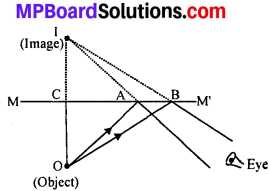
Question 10.
In figure, complete the image of the coin after reflection at the surfaces of both the mirrors?
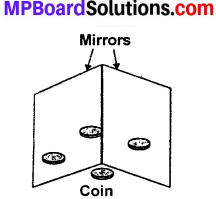
Fig. A ray diagram for formation of image by a pair of inclined mirrors.
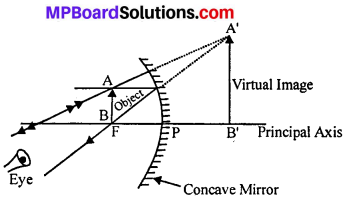
Question 11.
Differentiate between real and virtual image formed by mirrors?
Answer:
Difference between real and virtual image:
Real image:
- It can be obtained on a screen.
- It is inverted.
- It is obtained on the same side of mirror as the object.
- Rays converge at a point to form the image.
Virtual image:
- It cannot be obtained on a screen.
- It is erect.
- It is formed always behind the mirror.
- Rays appear to diverge from a point where the image is formed.
Question 12.
Draw concave and convex mirrors?
Answer:
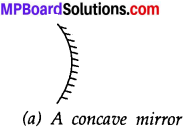
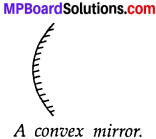
Question 13.
Draw convex and concave lens?
Answer:
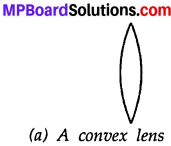
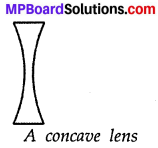
Question 14.
Differentiate between reflection and refraction?
Answer:
Differences between reflection and refraction:
Reflection:
- The speed of light remains the same.
- The incident ray and the reflected ray travel in the same media.
- In reflection the ray of light gets reflected back into the same medium.
Refraction:
- The speed of light varies as it travels from one medium to another.
- The incident ray and the refracted ray travel in different media.
- In the refraction the ray of light bends at the surface of separation between the two media.
Question 15.
Define mixing of colours? What is the color of the object as the red and green glasses?
Answer:
When two colours mix or overlap, a third color is produced. Thus, red + green = yellow; red + blue = magenta; red + blue + green = white and so on. In fact, any color can be obtained by the combination of red, green and blue which are called the primary colours. The colours so produced. From them are called secondary colours. The mixing of colours can be shown with the help of the diagram given in fig.
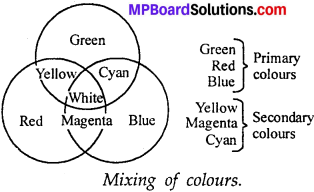
Light Long Answer Type Questions
Question 1.
Explain the image formation in plane mirror?
Answer:
A mirror with a plane surface is called a plane mirror. The ordinary mirror we use is a plane mirror. Formation of image is one of effects on reflection of light. The image is seen behind the mirror and it is of the same size as the object. The distance from the object to the mirror and the distance between the mirror and the image are equal. In the plane mirror the right side of the object appears to be left side of the image, and the left side of the object appears to be the right side of the image. This inversion of sides is known as lateral inversion.
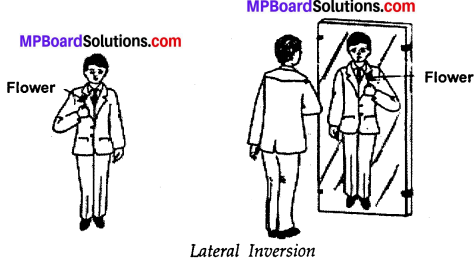
Question 2.
Define Newton’s experiment?
Answer:
Newton’s Experiment:
The idea that sunlight consists of several colours was first put forward by Sir Isaac Newton. He passed a narrow beam of light into a prism. The light that emerged from the prism was found to be coloured as in a rainbow. He gave the name spectrum to this coloured patch of light. The spectrum was seen to consist of seven colours of light – violet, indigo, blue, green, yellow, orange and red. The various colours found in white light can be easily remembered as VIBGYOR. The process of splitting up of white light into different colours is called dispersion of light.
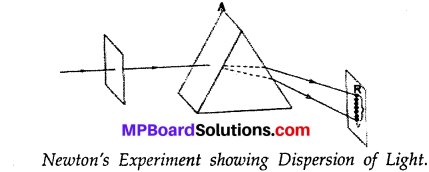
Question 3.
Explain rainbow?
Answer:
Rainbows are formed by sunlight falling on rain drops. The rainbow is always observed with the back towards the sun. The rainbow is formed when rain drops owing to refraction and internal reflection produce deviation and dispersion into seven colours of the sunlight falling on them. The rainbows are visible only when the altitude of the sun is less than 42°.
A full rainbow can be seen from an aeroplane flying at higher altitudes. It is a matter of common observation that when one looks at a spray of water on which sun shines, rainbows are seen. When you look at the water falls with the sun shining at your back, a circular rainbow will be seen. In a common rainbow (primary rainbow) the violet color is observed in the inner fringe and red on the outer fringe.
Question 4.
How will you show that combining seven colours, we get white light?
Answer:
Take a circular cardboard disc of about 10 cm diameter. Divide this disc into seven segments. Paint the seven rainbow colours on these segments as shown in Fig. (a). A small hole is made at the center of the disc. Fix the disc loosely on the tip of a refill of a ball pen. Ensure that the disc rotates freely [Fig.(a)]. Rotate the disc in the daylight. When the disc is rotated fast, the colours get mixed together and the disc appears to be whitish [Fig. (b)]. This disc is popularly known as Newton’s disc.
